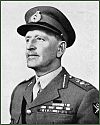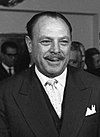Commander-in-Chief of the Pakistan Army
| Commander-in-Chief of the Pakistan Army | |
|---|---|
| پاک فوج کا کمانڈر ان چیف | |
 Flag of the Pakistan Army | |
| Ministry of Defence Army Secretariat-I at MoD[1] | |
| Abbreviation | C-in-C |
| Seat | Army GHQ Rawalpindi Cantonment in Punjab, Pakistan |
| Nominator | Governor General of Pakistan, Prime Minister or President of Pakistan |
| Appointer | Governor General of Pakistan, Prime Minister or President of Pakistan |
| Formation | 15 August 1947 |
| First holder | Gen. Frank Messervy |
| Final holder | Lt. Gen. Gul Hassan Khan |
| Abolished | 3 March 1972 |
| Succession | Chief of Army Staff |
| Deputy | Deputy Commander-in-Chief of the Pakistan Army Chief of General Staff |
The Commander-in-Chief of the Pakistan Army (reporting name: C-in-C) was normally the highest-ranking officer in the Pakistan Army from the country's independence to 1972; it was the commander-in-chief of the army.[2]: 105 The C-in-C was directly responsible for commanding the army. It was an administrative position and the appointment holder had main operational command authority over the army.
Direct appointments to the command of the Pakistan Army came from the British Army Council until 1951, when the first native Pakistani commander-in-chief (General Ayub Khan) was nominated and appointed by the Government of Pakistan.[3]: 24
The C-in-C was assisted by a deputy C-in-C until the late 1960s. The last deputy C-in-C was General Abdul Hamid Khan, who served until 1969. The C-in-C designation was changed to 'Chief of Army Staff' in 1972, General Tikka Khan was the first person to hold the new title. Six men have served as C-in-C, the first two of them were native British and the post was largely akin to the post of Commander-in-Chief of the Indian Army.[4][5][6][7][8]
History[]
This section needs expansion. You can help by . (December 2020) |
Prior to creation of Pakistan from the partition of India on 14 August 1947, the senior military general officer commanding of the Pakistan Army were the ad-hoc appointments made by the Army Board of the British Army.[9]
The appointment was known as Commander-in-Chief, India who directly reported to the Governor-General who was also under British monarchs.[10]: 105 Field Marshal Sir Claude Auchinleck was the last Commander-in-Chief of the undivided British Indian Army who became the supreme commander of India and Pakistan on 15 August 1947 serving till November 30 of the year.[10]: 105 On 15 August General Frank Messervy became the first C-in-C of the Pakistan Army and General Ayub Khan was the first native Pakistani to hold the appointment. However Ayub didn't hold the substantive rank of full general till 1957 as no field corps was established in the army.
In 1969, when General Yahya Khan became President of Pakistan, the then deputy commander-in-chief of the army Lieutenant General Abdul Hamid Khan was promoted to full General and was appointed as the 'Chief of Staff of the Army', a newly created post which was akin to Chief of Staff of the United States Army.[6]: contents On 20 March 1972, the commander-in-chief post was renamed as "Chief of Army Staff (COAS)" with Lieutenant-General Tikka Khan elevated to four star rank to be appointed as army's first chief of army staff.[11]: 62
The term of the superannuation was then constrained to three years in the office as opposed to four years and was made a permanent member of Joint Chiefs of Staff Committee.[11]: 62
Appointees[]
The following table chronicles the appointees to the office of the Commander-in-Chief since the independence of Pakistan.
Commander-in-Chief, Pakistan Army (1947–1972)[]
| No. | Portrait | Commander-in-Chief | Took office | Left office | Time in office | Unit of Commission | Notes |
|---|---|---|---|---|---|---|---|
| 1 | General Sir Frank Walter Messervy KCSI, KBE, CB, DSO & Bar (1893–1974) | 15 August 1947 | 10 February 1948 | 179 days | 9th Hodson's Horse | The first commander-in-chief of the army who was in the acting rank of full general. | |
| 2 | General Sir Douglas David Gracey KCB, KCIE, CBE, MC & Bar (1894–1964) | 11 February 1948 | 16 January 1951 | 2 years, 339 days | 1st King George's Own Gurkha Rifles (The Malaun Regiment) | The last British person to hold the C-in-C title, served as an acting full general like his predecessor. | |
| 3 | Field Marshal Muhammad Ayub Khan NPk, HJ, HPk,MBE (1907–1974) | 17 January 1951 | 27 October 1958 | 7 years, 284 days | 14th Punjab Regiment | The first native Pakistani person to be the C-in-C and as a substantive full general to hold the appointment, also the first chief to become President of the country. He was a self promoted Field Marshal after becoming the President.[12] | |
| 4 | General Muhammad Musa Khan HPk, HJ, HQA,MBE (1908–1991) | 27 October 1958 | 17 September 1966 | 7 years, 325 days | 4th Hazara Pioneers | C-in-C during the Indo-Pak war of 1965 and also the longest serving officer to hold the post. | |
| 5 | General Agha Muhammad Yahya Khan (1917–1980) | 18 September 1966 | 20 December 1971 | 5 years, 93 days | 10th Baluch Regiment | Second chief to be served as President of the country from 1969 to 1971. | |
| 6 | Lieutenant General Gul Hassan Khan (1921–1999) | 20 December 1971 | 2 March 1972 | 5 years, 93 days | Frontier Force Regiment | Last C-in-C of the Pakistan Army, serving till 1972 in the rank of lieutenant general. |
Senior commanders during 1965 and 1971 Wars[]
During the 1965 Indo-Pakistani War, there were only two Lt. Gens in the Army; Bakhtiar Rana the Commander I Corps and Altaf Qadri who was on deputation to CENTO, Turkey and a handful of Maj. Gens.[13]
During the 1971 Indo-Pakistani War, there were two full generals and the number of Lt Gens reached to 13; four were posted at the GHQ/CMLA HQ, one at the CENTO HQ in Ankara, Turkey, four were corps commanders, four were governors under the martial law. General Yahya Khan was the President of Pakistan, General Abdul Hamid Khan was the de facto Commander-in-Chief of the Army, Lt Gen S.G.M.M. Peerzada was the PSO CMLA HQ in Rawalpindi, Lt Gen Gul Hassan Khan was the Chief of General Staff (CGS), and Lt Gen Khwaja Wasiuddin was the Master-General of Ordnance (MGO).The GHQ posts of QMG and AG was under the rank of Major-Generals. Lt Gen Muhammad Shariff was sent as Permanent Representative to the CENTO HQ in Turkey. Army's Eastern Command was under Lt Gen A.A.K. Niazi, I Corps was under Lt Gen Irshad Ahmad Khan, II Corps was under Lt Gen Tikka Khan, IV Corps was under Lt Gen Bahadur Sher. On the other hand, governor Punjab was Lt Gen Attiqur Rahman, governor Sindh was Lt Gen Rakhman Gul, governor NWFP was Lt Gen K.M. Azhar, and governor Balochistan was Lt Gen Riaz Hussain.
References[]
- ^ MoD, Ministry of Defence. "Organogram of MoD" (PDF). Ministry of Defence (Pakistan). Ministry of Defence Press. Retrieved 22 July 2017.
- ^ Bajwa, Kuldip Singh (2003). "Kashmir Valley saved". Jammu and Kashmir War, 1947-1948: Political and Military Perspective (googlebooks) (1st ed.). New Delhi, India: Har-Anand Publications. p. 320. ISBN 9788124109236. Retrieved 3 December 2017.
- ^ Harmon, Daniel E. (2008). Pervez Musharraf: President of Pakistan: Easyread Super Large 20pt Edition. ReadHowYouWant.com. ISBN 9781427092038. Retrieved 3 December 2017.
- ^ Cheema, Pervaiz Iqbal (2002). "Defence Administration". The Armed Forces of Pakistan (google books) (1st ed.). New York, U.S.: NYU Press. p. 225. ISBN 9780814716335. Retrieved 25 July 2017.
- ^ Shabbir, Usman (2003). "Command and Structure control of the Pakistan Army". pakdef.org. PakDef Military Consortium. Archived from the original on 7 January 2019. Retrieved 24 July 2017.
- ^ a b Cloughley, Brian (2016). A History of the Pakistan Army: Wars and Insurrections. Skyhorse Publishing, Inc. ISBN 9781631440397. Retrieved 24 July 2017.
- ^ "Pakistan: Army and Paramilitary Forces". Factba.se. Retrieved 16 December 2013.
- ^ "The Army Chief's". www.pakistanarmy.gov.pk. Archived from the original on 4 December 2013. Retrieved 16 December 2013.
- ^ Lenze Jr (2016). Civil–Military Relations in the Islamic World. Lexington Books. ISBN 9781498518741. Retrieved 21 July 2017.
- ^ a b Bajwa, Kuldip Singh (2003). "Kashmir Valley Saved" (google books). Jammu and Kashmir war, 1947-1948 : political and military perspective (1st ed.). New Delhi: Har-Anand Publications. p. 350. ISBN 9788124109236. Retrieved 24 July 2017.
- ^ a b Singh, Ravi Shekhar Narain Singh (2008). "Military and Politics" (googlebooks). The Military Factor in Pakistan (1st ed.). London, UK: Lancer Publishers. p. 550. ISBN 9780981537894. Retrieved 24 July 2017.
- ^ "Gen. Ayub becomes President". Dawn. 6 September 2017. Retrieved 23 October 2017.
- ^ Shaukat Qadir. "1965: Operation Grand Slam" Daily Times, 4 October 2003
- Commanders-in-Chief, Pakistan Army
- Chiefs of Army Staff, Pakistan







